
Have you ever felt that there is more to a subject than you know? That precisely you have only explored the surface of the iceberg? That by digging a little bit you could find wealth and new perspectives? Well that's the feeling I had with Dave Snowden's Cynefin framework. Indeed, it seems unthinkable to me today to introduce the concepts of agility without introducing the notion of complexity, whether for team practice or for support and coaching.
I have often chosen to talk about the Stacey matrix which seemed more obvious to me to explain, but I appreciate more and more the contribution of the Cynefin framework on decision-making and the associated modes of leadership. I then embarked on its exploration (not without pitfalls!) and share with you in this series of articles, between the translation and the restructuring of information, what I have humbly retained. 😉
Other articles in the series:
Author: Dave Snowden

Dave Snowden is a Welsh academic, consultant and researcher (those who met him will remember! :-P) in the field of knowledge management. His initial training is a combination of physics and philosophy which allowed him to have a look at the social sciences from different perspectives.
He is the founder and Chief Scientific Officer of Cognitive Edge, a consulting firm and research network working to make sense of complexity theory for action.
He developed the framework Cynefin, a practical application of complexity theory to management science.
He often describes himself as a " constructive irritant in the sense that he will tend to push certain remarks to the extreme to get his ideas across. Indeed, according to him, the danger lies in the fact that when we hear something with a familiar language, we risk associating it with what we know when it is a totally different notion. It is not uncommon to see people using new terms and applying them to methods they have already been using for 10 years!
These conferences are tinged with humor, concrete examples and scientific terms, which makes its content very rich.
The Cynefin Framework
Origin of the name

First of all, Cynefin is a word of Welsh origin that is pronounced “ku-ne-vine”. Its literal translation is "Habitat" or "Place" but it means more precisely "the place with multiple affiliations".
It's the feeling of being deeply influenced by our roots (cultural, religious, geographical, tribal) and by other multiple factors of which we can only be partially aware: a name therefore rather well chosen for a model of complexity .
Vocabulary
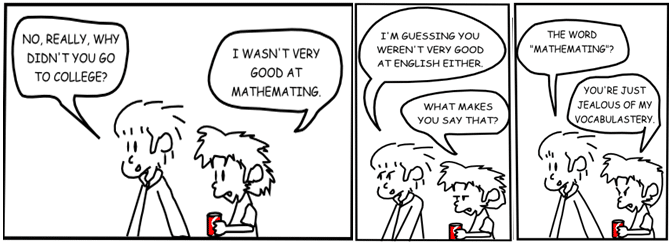
Before embarking on the discovery of the Framework, let's agree on the meaning of a few words used.
- System : any network with coherence
There is meaning in the gaps between things, not in the things themselves.
–Alicia Juarrero
It is therefore the interactions between people that count, not the people. There is therefore a significant conceptual shift because we tend to focus on changing individuals rather than changing the way they interact with each other. This approach is indeed more effective: trying to change each person is too difficult, changing the systems in which they work allows them to change more quickly.
So focusing on the concepts of networks and coherence is one of the great novelties: it means learning to manage these vague gaps between things.
- Agent : everything that acts in or on the system
It is important to realize that agents in human systems are rarely individuals. They are usually cohesive groups of common people, interests, myths, or stories. It is also interesting to know that myths have much more impact as agents in human systems than people.
Indeed, there is no genetic difference between us. The difference comes from the patterns embedded in the histories of the societies in which we grew up. We cannot escape the stories of the group in which we are. According to a study carried out on the mapping of culture in companies, it only takes 2 to 3 months for a newcomer to a company with a strong culture to be able to tell stories similar to those of people who have been there for twenty years. We are narrative-based creatures and we like to conform.
Description of framework
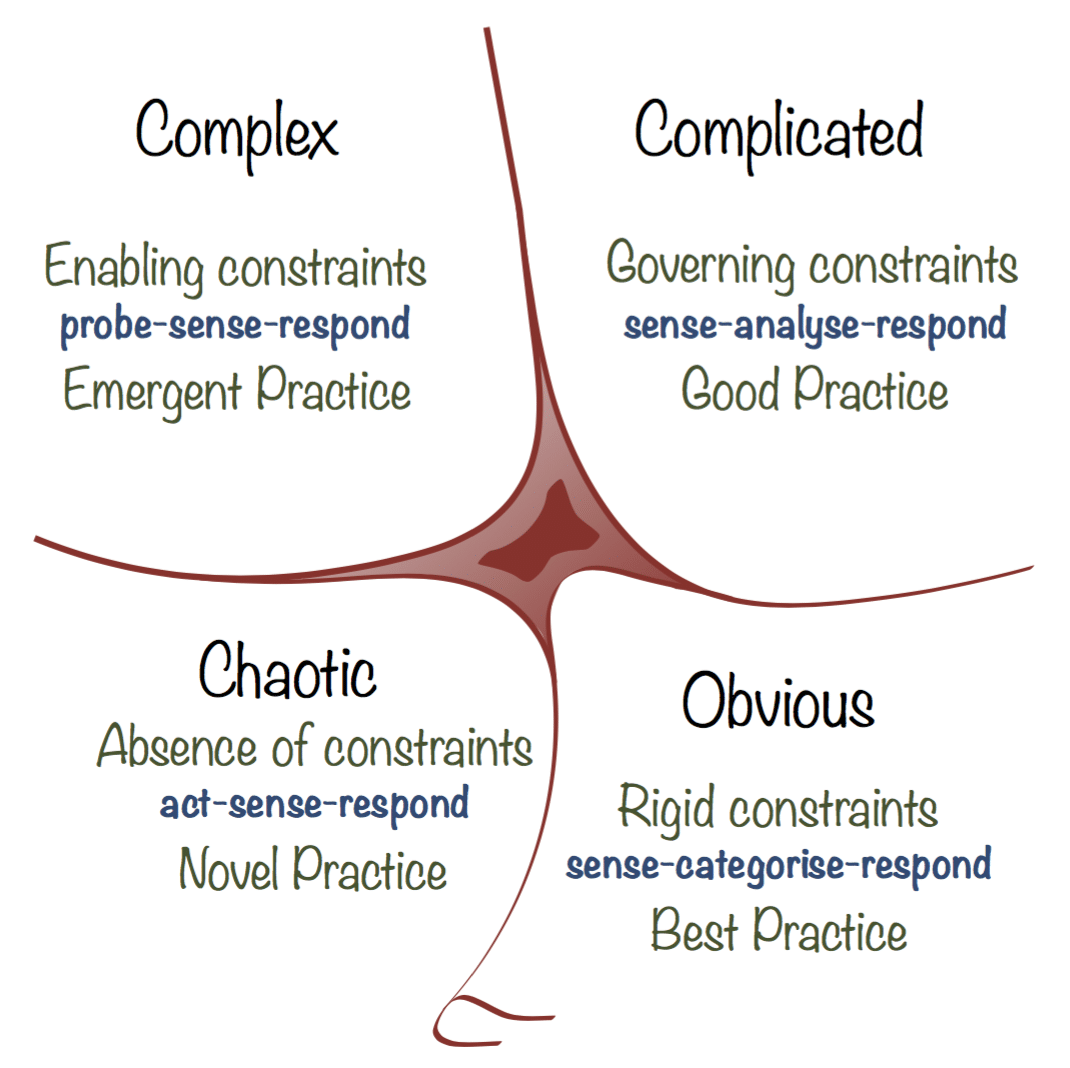
Despite its appearance, the Cynefin framework is not a categorization model in the form of a 2×2 matrix but rather a “Sense Making” model – or as Dave Snowden would put it, “ how to make sense of the world so that you can act within it“.
The difference lies in the fact that for a categorization model, the framework precedes the data whereas for a Sense Making model it is the opposite: the patterns or the framework itself emerges from the data.
However, categorization has its advantages: it is fast. Just drop the data in the right boxes and decide accordingly. The danger is that we risk being caught off guard because we only see the most subtle differences too late. Categorization is good for mining data but not for exploring it at the rate of change.
The framework is built on the basis that there are 3 types of systems in nature: ordered, complex and chaotic systems.
We then divide the ordered systems into obvious and complicated – the reason for this is a matter of people's perception, which matters. We then add a new category called Disorder.
One important thing to keep in mind is that there is no best system, they are all contextually appropriate. Each then has characteristics (type of constraints, decision model, typology of practices) that it is important to understand in order to be able to act better.
Ordered system
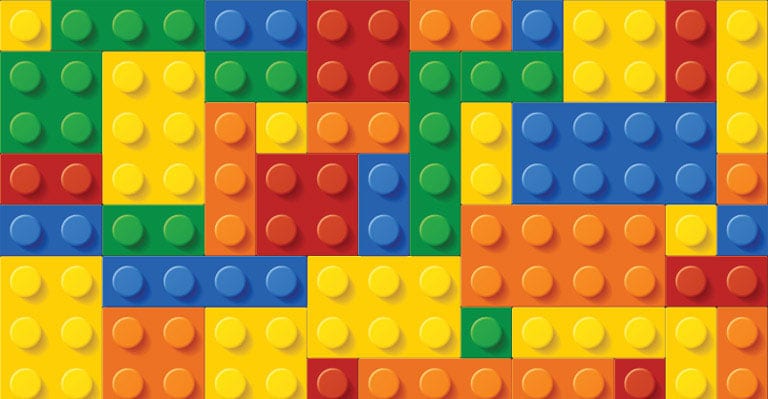
An ordered system is a system with a very high level of constraints. There are no degrees of freedom so the behavior of the agents is totally controlled and predictable. This is unique to humans and we're pretty good at it. Indeed, it is important to understand that everything that involves humans is not necessarily "complex" because with intelligence, we can and we know to put process controls in place imposing order - and that is a good thing ! The problem is that we push it too far. One begins to desire order independently of utility.
Now, if one imposes an excessive level of constraints that the system does not support, things will go underground. In his years at IBM, Dave and his colleagues discovered that there was a direct correlation between an organization's perceived level of bureaucracy and the density of informal networks. The reason is simple: the higher the level of bureaucracy, the more people you need to know (or at least the right people) to make things happen!
The problem with this type of system is that people use this survival mechanism to hide the failures of the system: as human beings, we don't like things to go wrong (which is to our credit) which makes us strive to make the system work despite rules that prevent us from doing so. The danger is that when the failure surfaces, it is a real disaster because the tension in the system has built up and a massive disruptive change is achieved.
The order has value as long as the system has the capacity to support it, otherwise it is dangerous.
-
Obvious System: the domain of Best Practices

A simple system is an ordered system, which means that the relationship between cause and effect exists, is predictable, and can be determined in advance.
The relationship being obvious, the corresponding decision model is: feel – categorize – respond. We see what happens, we put it into categories and we decide what to do according to established practices.
We can then apply Best Practices because everyone has agreed to do things in a certain way. We therefore have rigid constraints.
-
Complicated System: the domain of Experts

Complicated system – build an airplane
In a complicated system, there is a relationship between cause and effect but it is not obvious.
We can then call on an expert and deploy an analytical method of the type feel – analyze – respond. It is then possible to define a repeatable, sustainable and scalable approach that will always produce the same result.
We do not then apply Best Practices, but Good Practices. This distinction in terminology may seem trivial, but it is in fact particularly important. Indeed, in the domain of the complicated, there are multiple ways of doing things – all legitimate if one has the right expertise, hence the fact that one has applicability constraints (rather than constraints). rigid) allowing for the variability of the solutions in the scheme.
Complex System: the domain of Emergence

A complex system is a system without causality. It is a system in which constraints and agents co-evolve. The constraints are flexible and negotiable, we can speak of co-evolution. When patterns are formed, they stabilize but you can't go back, whatever happens. We are therefore always working on current stability or instability.
Dave Snowden evokes the metaphor of a round table around which there are electromagnets and in the middle iron ball bearings. If one of the magnets is changed, the ball bearing change pattern evolves in a predictable and repeatable manner. In systemics, the magnet is called the “pilot” (driver). This is what everyone wants to know: the behavior of the driver. In a complex adaptive system there are many magnets and in fact they all change at the same time. So you're going to change that magnet this time and it's going to have that effect, the next time you do it it's going to have a totally different effect. In complexity theory, magnets are called "modulators".
A complex adaptive system is therefore “modulated” and not “driven”. Little things produce drastically different effects, you don't get repeatability: a complex adaptive system is not causal in the conventional sense but dispositional. If an event recurs, it is by accident, but we can measure the disposition of the system to evolve in different directions.
In a complex system, we experiment with constraints to see what is sustainable. We do not impose constraints until we know if it is valid. A key aspect is moving from secure design to multiple Safe-to-Fail experiments.
The decision model here is of the type probe – feel – respond.
If an experiment succeeds, we amplify it. If an experiment begins to fail, we tone it down. An experiment should only be performed if one has identified amplification or mitigation strategies in advance.
What you get here is an emergent order, something that comes from an emergent, new practice. It may be the result of a combination, but it is nonetheless different and unique.
Chaotic System: the realm of rapid response

In a chaotic system, there are no constraints. The relationships between cause and effect are therefore impossible to determine because they are constantly changing and no maneuverable patterns exist – only turbulence. It is the domain of the unknowable and each agent is independent of the others. This last element can be of great value for the concept of wisdom of crowds for example which states that the aggregation of information in groups, resulting in ratings, will often be better not only than those of isolated individuals in the group, but than the average of the group's ratings (the difference coming from a taking into account diversity information, hence the importance of independence).
2 scenarios can then be distinguished:
- if we enter it deliberately it is for innovation
- if you enter it by accident then you need to stabilize a position quickly.
The decision model here is of the type act – feel – respond. We move very quickly to stabilize the situation.
Any practice will be completely new in view of the current operation.
Note: this system is very difficult to sustain because the effort is enormous to keep the elements independent.
Mess

The central space corresponds to disorder. It is a key space (non-existent to my knowledge in the Stacey Matrix) where one is when one does not know in which domain one is located. And that's where we are most of the time. The difficulty then is that we tend to interpret the situation according to the way we personally prefer to act.
- Simple: if we have spent some time in our lives in a purely bureaucratic environment, the danger is that we will tend to see any problem as a process failure.
- Complicated: As an expert, any problem is due to a lack of time or resources to perform an analysis.
- Complex: Politicians are naturally complex people. Their reaction in a crisis situation is to bring together a large number of people with different profiles and backgrounds in the desperate hope that someone will find the right solution, which is ultimately a pretty good strategy.
- Chaotic: The fascist lever in a crisis situation is to obtain absolute command so that everyone does what they are told to do.
So what you get in a normal decision environment is that people are in a messy space, evaluating the situation according to their preferred course of action.
The border between the simple and the chaotic
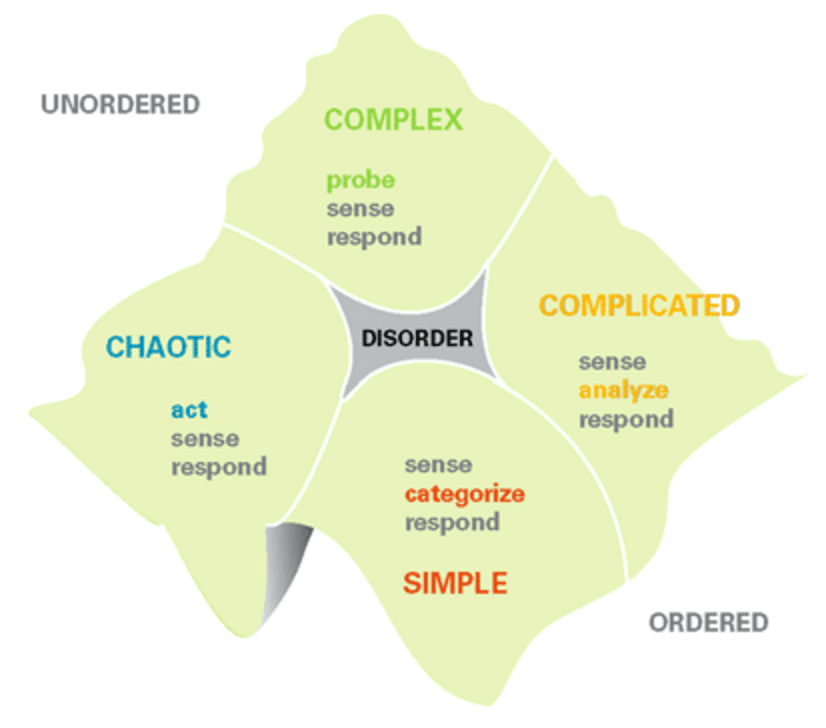
One aspect often overlooked by people trying to oversimplify the Cynefin framework is the boundary between simple and chaotic systems that turns out to be different from others. Indeed, it is represented in the form of a cliff in theoriginal article in Harvard Business Review, or as a symbolic wave in other articles.
The principle here is that if we begin to believe that things are simple, we begin to believe that they are orderly, we begin to believe in our own myths, we begin to believe that our past successes make us invulnerable to future failures. We then effectively move towards the zone of complacency which is the border between the simple and the chaotic until the moment when we fall into the void, directly into a crisis.
All the other borders allow transitions, for this one we fall into the void and the recovery is very very expensive.
We should then manage in complicated and complex spaces and move only a tiny quantity of elements in the simple because very little vulnerable to rapid changes.
The example of the children's party

Here is the metaphor used by Dave Snowden many times to illustrate the different types of systems.
Imagine that you want to apply the different types of systems that exist in nature to the organization of a party for children of about ten years:
chaotic environment

Assuming the party is chaotic, the children act randomly. They might even be embarking on a personal experience of self-discovery using drugs and alcohol, and your house might even burn down in the process. I have friends in California who have tried but never more than once, the cost of recovery being particularly high.
Ordered environment
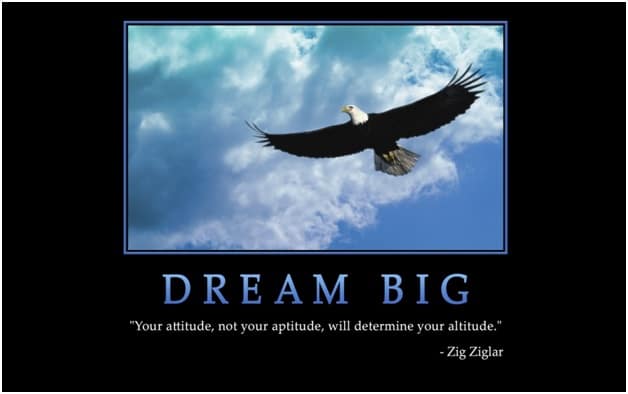
Here it is of critical importance to construct clearly articulated learning objectives in advance. These should of course be aligned with the mission statement for education in the society to which you belong. Ideally, you could print these learning objectives on motivational posters with images of eagles soaring in the valley or water falling into lakes and place them in the room where the party will be held.
You then produce a project schedule for the party. This project schedule should have clear milestones throughout the party that you can measure progress against against ideal party outcomes.
Once that's done, senior adults can get the party started with a motivational video (after all you don't want the kids wasting their time playing – which isn't aligned with the learning goals of the game). party itself) and should use PowerPoint to demonstrate their personal commitment to the goals of the party and show children how their pocket money is linked to the achievement of set goals.
After the highly successful completion of the party, you conduct a review of future actions, update your party management best practices database, and mandate future process improvements.
Complex environment
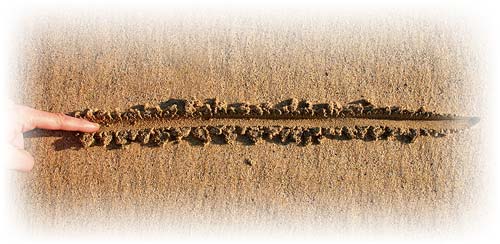
The complex approach is even simpler. It is also sometimes called “the new simplicity”. Here, we draw a line in the sand (known as a boundary/limit in complexity theory), turn to the children and say:
“Pass this line strip of little ******* and you will die”
One thing you learn quickly as an adult is the value of flexible, negotiable boundaries. Indeed, rigid boundaries have a habit of becoming brittle and catastrophically breaking. We then use catalytic probes (football, video, barbecue, video games), something that will stimulate a pattern of activity that we call an attractor. If it is a beneficial attractor, it is stabilized and amplified, if it is a negative attractor, it is attenuated or destroyed very quickly.
The fundamental principle of complexity theory applied to organizations or software development is therefore:
Manage the emergence of a beneficial coherence within attractors, within limits.
We manage the boundary conditions, we manage the probes, we manage the emergence of beneficial coherence. It is an evolutionary process that takes far fewer resources than the ordered approach, but produces more beneficial results despite the fact that they cannot be predicted in advance.
Cynefin dynamics and cadences
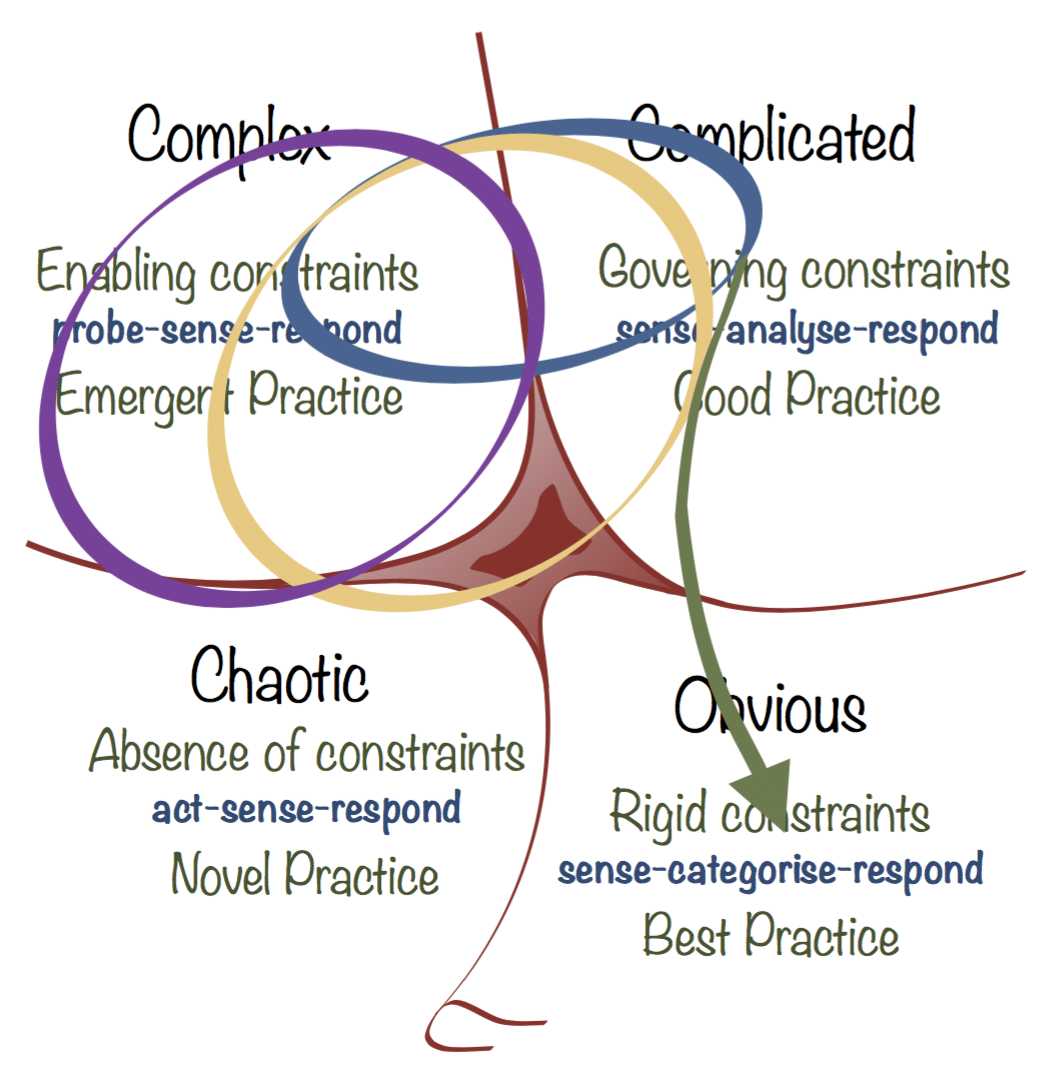
Putting methods (Scrum, Kanban, etc.) in boxes is a bad idea. Most of them are rather transition mechanisms between domains not within domains; and they have value because of this.
Scrum is a very effective transition method between the complex and the complicated.
What must be kept from Cynefin is that it is in fact a question of dynamics, of cadences.
The strategic level (in blue)
This is what we really want to achieve at the strategic level. When a pattern emerges and becomes visible in the complex domain (exploration), the constraints are increased so that it can be studied (exploitation). We relax the constraints in such a way that new patterns become evident. It is thus a mechanism where one tests the constraints for the repeatability. It is a natural cadence in which one must give oneself the possibility of being able to return to the previous state of stability.
The reset (in yellow)
Otherwise we enter what is called the "slight dive into chaos". We never do a deep dive because people may not recover. What we do then is get rid of the constraints for a very short time so that new patterns can emerge. This dynamic is usually used during major resets.
What won't change (in green)
A small amount of elements go into the realm of the obvious. These elements move there to die: be careful, these elements can take about twenty years to die and constitute 60 % of your business. So it's not that they aren't important, but rather that they won't need to be changed. When things don't need to change, we codify them and make them rigid.
Note: the only place structured methods work is when you start out complicated and go to the obvious. Everything else produces inauthentic behavior so it won't work (or by accident).
Grazing dynamics (in purple)
This is a case where the pace of change does not allow us to stabilize and we need to maintain constant experimentation approaches which has great implications for architecture and modularization.
Conclusion
Here is the end of this first article centered on the Cynefin Framework and its characteristics.
The second article will focus on model changes related to the contributions of complexity theory and complex adaptive systems.
References
- Dave Snowden: https://en.wikipedia.org/wiki/Dave_Snowden
- HBR Item: https://hbr.org/2007/11/a-leaders-framework-for-decision-making
- Cognitive Edge: http://cognitive-edge.com/
- The Cynefin Framework: https://www.youtube.com/watch?v=N7oz366X0-8
- How to organize a children's party: https://www.youtube.com/watch?v=Miwb92eZaJg
- Making Sense of complexity: https://www.youtube.com/watch?v=y6RfqmTZejU
- Simple but not simplistic: https://www.infoq.com/fr/presentations/scrumday-dave-snowden-simple-but-not-simplistic
- An excellent article from SOAT: http://blog.soat.fr/2014/01/le-framework-cynefin-et-la-gestion-des-connaissances/
- Wisdom of Crowds: https://fr.wikipedia.org/wiki/La_Sagesse_des_foules
- Strategic Understanding with Prof. Dave Snowden: https://www.youtube.com/watch?v=PFi9mIlp2NY
- Think new, Act new: https://www.youtube.com/watch?v=s8SayvnfQi0







8 Responses
Thank you for this excellent article, everything is there! I took the liberty of linking to your article here: https://www.in-imago.com/blog/outils-pour-un-m…tegique-efficace/
Thank you for this excellent article. Everything is there! I took the liberty of putting the link to your article in mine:https://www.in-imago.com/blog/outils-pour-un-management-strategique-efficace/.
Thank you for your article.
However, there is one point that puzzles me. This is the difference that is made there between the 'complicated' and the 'complex' ie 'complex' can also be defined as the opposite of 'simplex'. It is the notion of the 'whole' made up of its parts. Essential concept in system engineering for the analysis of problems when a 'complex' problem (/system) is broken down into 'complicated' sub-problems (/sub-systems) in order to understand its complexity. What do you think ?
Cheers,
Hello Francois,
Thank you for your message.
I think that in all fields, there is a terminology that allows us to make sense of it and use it in our context. And often unfortunately, the same words do not have the same meaning (it would be too easy otherwise!)
Not being familiar enough with the field of “systems” engineering, the only thing I can say is that by the way you described it, it fits well in what is put behind the field “ Complicated” by Cynefin. Indeed, the notion of a major problem that can be broken down (and therefore recomposed) into sub-problems is by definition a matter for the complicated. Moreover, the associated strategy is mainly analysis of the problem in order to then be able to respond to it – which starts from the principle that a cause and effect solution exists and that it suffices to seek it.
In the "Complex" domain, typically a human system, would lead to a more empirical approach: a definition of a study framework with expected results and a conclusion a posteriori.
The initial postulates and the associated strategy are therefore slightly different depending on what is put in one domain or another, however this is often relative to the perception of each on the belonging of such or such subject to such or such domain.
Beautiful day !
Olivier
En fait la distinction complex/complicated vient du bouquin de Cilliers Complexity and Postmodernism. Un avion c’est compliqué: plein de parties et de relations dures a appréhender mais il est possible de les connaitre et de les prévoir (l’avion ne change aps de comportement quand il voit le reparateur arriver) et donc d’etre expert en avion sinon on montrait pas dedans. Une société c’est evolutionnaire, quand tu parles de restructuration dans le hall y’a deja des agents qui ont changé de comportement donc c’est insaisissable et on peut pas être expert mais jsute lancer des safe to fails probes.
Thank you Olivier for your answer.
On the notion of Order, disorder and emergence there is also this article https://philosciences.com/philosophie-et-societe/17-edgar-morin-complexite.
Good day,